4th January, 2023
44 Min read
Sign up to our Newsletter
With the increasing demand for speedy and efficient content delivery, advanced solutions like the Content Delivery Network (CDN) have emerged. But what does CDN actually mean? Essentially, it’s a network of strategically positioned servers aimed at enhancing the speed and dependability of delivering content to users in different locations. These servers store cached copies of content, ranging from web pages to videos, guaranteeing that when a user makes a request, it’s served from the closest server available. This reduces delays and speeds up loading times.
When a user requests specific content, CDN architecture comes into play. It directs the request to the nearest server, taking into account factors like server health and proximity. This approach minimizes data travel distance, resulting in fast and efficient content delivery. Take a deep dive into our complete article to fully grasp the extensive scope and importance of CDNs in today’s digital world.
How One AI-Driven Media Platform Cut EBS Costs for AWS ASGs by 48%

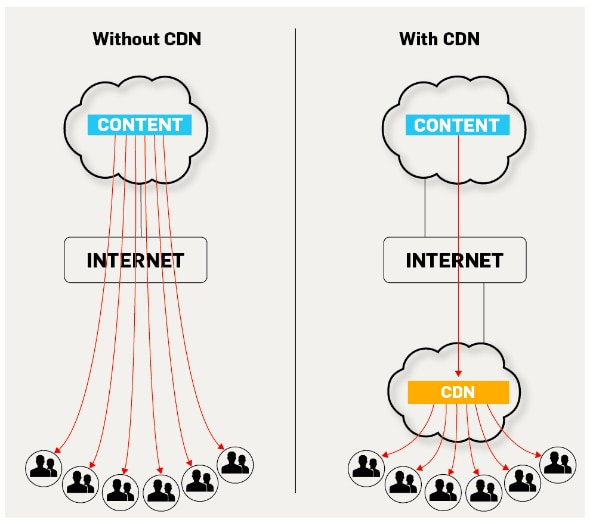
CDNs are designed to optimize the delivery of web content, and some of the main advantages that they provide to a company and its users include:
Here’s a simple model of a Content Delivery Network, its key components and their roles explained below:
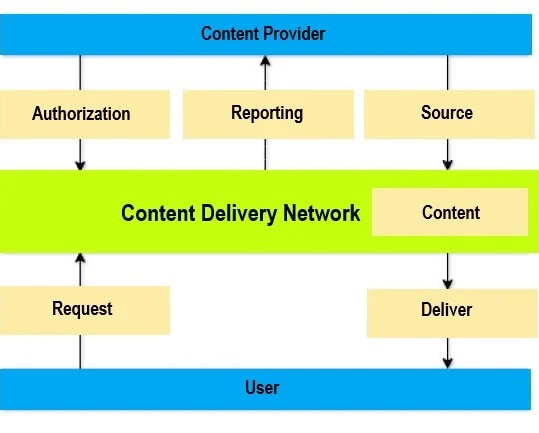
Most CDN architectures are designed using these key components:
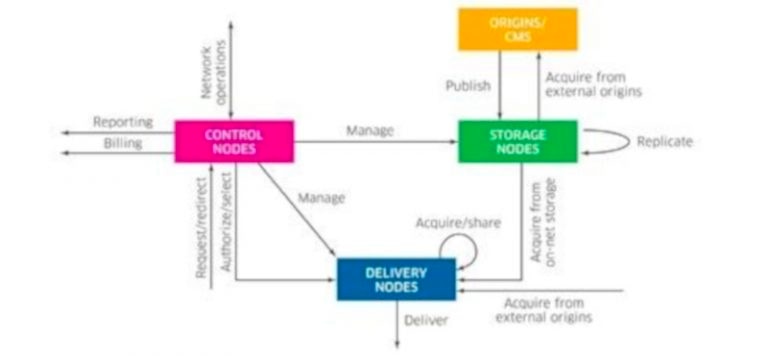
A model of CDN architecture. Source: Richard Gibbs – A new approach to publishing and caching video
Benefits include reducing bandwidth costs, improving page load times, or increasing the global availability of the content. The number of nodes and servers making up a CDN varies, depending on the architecture, with some reaching thousands of nodes with ten thousands of servers on many remote points of presence (PoPs). Others build a global network and have a small number of geographical PoPs.
CDN nodes are usually deployed in multiple locations, often over multiple backbones. Benefits include reducing bandwidth costs, improving page load times, or increasing the global availability of the content. The number of nodes and servers making up a CDN varies, depending on the architecture, with some reaching thousands of nodes with ten thousands of servers on many remote points of presence (PoPs). Others build a global network and have a small number of geographical PoPs.
There are 3 primary types of content:
A CDN is built upon a network of interconnected servers strategically placed to minimize the distance between a user and the nearest server. These servers cache copies of web content.
When a user requests a webpage, dynamic request routing ensures that it goes to the closest available CDN server. If the CDN server has a recent copy of the requested content in its cache, it responds directly to the request. If not, the CDN server will forward the request on to the origin server, which will fill the request. The CDN sever may also cache a copy of the response to support future requests.
The Domain Name System (DNS) translates domain names into IP addresses, which means that every request for web content begins with a DNS lookup. DNS-based CDN systems use DNS implementing request routing and redirection. When a user requests a particular webpage, they will use the same domain name regardless of location.
However, the DNS server will base its response on the location of the requester, directing the user to the most convenient CDN server. This design takes advantage of the design of DNS to perform request redirection without complex or inefficient additional infrastructure.
Netflix is a good CDN example. Sites like Netflix serve large multimedia files to their users, and at the same time, a positive user experience depends heavily on this content being delivered quickly to avoid video buffering.
Serving all video content from the origin server would be resource-intensive and increase network latency. Instead, Netflix uses CDN servers distributed across their service areas. When a user wants to watch a video, their request is filled by the most convenient CDN server, reducing network congestion and decreasing latency and video buffering.
A great user experience is everything when it comes to running a website. At one hand, the user expectations are huge; the site should provide interactivity, media and info, but on the other hand, the Internet is growing, making it harder and harder to provide a great user-friendly website.
When we think about website speed, we think about various ways to optimize the loading speed of different elements, including webpages, pictures, videos, apps and other elements the user saves to their computer or downloads through their Internet browser. Having a website with a high loading speed results in:
We can prove the importance of website speed optimization by using ecommerce as an example. In ecommerce, the number of sales is directly connected to the speed at which website content is being delivered.
A 2022 study by Portent, found that even small increases in page load speed have a dramatic impact on conversion rates:
Performance has a direct impact on your website revenue, metrics influence brand perception, loyalty and visitor engagement.
According to eMarketer estimates, retail e-commerce sales reached $5.2 trillion in 2021, a 17.1 percent increase over the previous year. The mobile share of this stood at an estimated 60.1 percent. In 2026, e-commerce could rake in some $8.1 trillion.
Consider the patience of your customers; the majority of Americans are said to wait in line (in a real shop) for no longer than 15 minutes. However, on the web, 1 out of 4 customers will abandon a webpage that takes more than 4 seconds to load.
More data that proves the connection between website speed and number of sales:
There are so many benefits of user performance but here are the top 3 reasons why you should care about maximum performance and top speed:
Long load time equals high bouncing rates. The bounce rate is an important factor that any website owner should ALWAYS take into account. In simpler terms, it’s when a user visits your website and rather than continue viewing other pages within the same site, leaves. It is considered as one of the most important measures of effectiveness for a website.
Considering the improved technology of today, a website with simple content should completely load within 2 seconds. Loading time is crucial since it directly affects the satisfaction or dissatisfaction levels of your visitors, and therefore your page revenue. In other words, time is of the essence!
Since April 2010, Google started to take load time into account when ranking sites. Of course, Google’s algorithm uses much more factors that determine how to rank search engine results, but the page load speed is taken into account and should be a priority. Improving your page load time is an effective way to help visitors get where they are going faster, and it helps you stay on top of the search results which is the best way to get spotted by potential users. Page speed matters now, more than ever. Whether your customers are there for a pretty interface, clear privacy policies, for the best bargain, or simply because they have found exactly what they were looking for, they had to get there in the first place, and quickly. If you could cut that path to your website even shorter, and this is a matter of milliseconds, you could convert more visits to actual orders.
Mobile users are more patient than computer users, main reason being is that they’re used to having slower internet speed. But considering today’s connection speeds, loading time for mobile is an important factor. As you may presume, things are different for mobile devices (including tablets) even though fixed connections are enough to not cause too many problems for website loading time. Mobile page optimization is more important than ever, since web browsing is now mainly done via mobile devices.
An advantage of 250 milliseconds of page load time, according to recent research, is what keeps your customer from going to a competitor. By choosing CDN over standard hosting, you ensure that the content is delivered from a server located closest to the end user. This will also save you money on buying additional hardware and software for the server.
The Internet is a constantly-changing mechanism, and new forms of data and content are constantly being created. Soon after it was made commercially available, the problem of pushing massive amounts of data to the end user as fast as possible had to be solved. Enter CDNs.
The roots of CDNs were created almost twenty years ago and continue to be the driving force of content delivery. Since its creation, there have been significant research efforts directed toward this technology by academia and commercial developers. CDNs could easily be considered as one of the top emerging technologies that impact our web experience.
The first Content Delivery Networks were built by Akamai Technologies, Inc. based in Cambridge, Massachusetts. Their CDNs are responsible for 15-30% of global Internet traffic. They have over 2200 Points of Presence in 120 countries and are affiliated with 1500 networks. Companies that followed suit and also built their CDNs include AT&T, Telstra and Deutsche Telekom.
Since the introduction of CDNs, the market has seen a significant boost in the delivery of broadband content and the streaming of audio, video and associated data over across the Internet. In short, this is the life cycle of CDNs so far:
The evolution of Content Delivery Networks can be organized in four periods:
CDNs have a decade-long history with roots spanning from the late 90’s and have always adapted to the changing technologies and other user requirements. After all, change is one of the basic principles that drives the web. However, it is difficult to predict what’s next for the CDN market, as there is so much research and development to be done. The development of content delivery networks sought to deal with extreme bandwidth pressures, first as video streaming was growing in demand as well as the number of content providers. That was in the past. With the emergence of cloud computing, CDNs have become a continual trend involving all layers of cloud computing:

Even though it is hard to accurately predict what the future of CDNs will be, one thing is certain: this industry will grow exponentially, which means that the technologies used to run them will develop even further.
The main goals for the future are performance, availability and security.
To understand how the CDN industry will continue to develop, we can use the development of traffic logistics in urban areas.
Many new technologies are being developed or tested as we speak, including systems for traffic jam prediction and automated cars (designed to be self-driven to prevent the occurence of traffic accidents). Their implementation could lead to totally new urban landscapes where traffic will be safer and there will even be more parking spaces.
The same is expected to happen in the CDN industry as well.
CDN Providers currently have only one way of collecting PoP performance data and that is through Log Files. Their sheer volume, variety and rate at which they are updated make problem solving, system upgrades and quality assessment that much more tasking.
For this reason, one of the goals for the future of CDN is developing predictive analytics and algorithms that can predict behavioral patterns based on machine learning. These technologies based on the OSI model of communication functions should replace BGP (Border Gateway Protocol), the technology currently responsible for directing Internet traffic, and completely eliminate security threats.
Facebook has already developed a similar technology called Open/R and Google has developed its own called Espresso.
The key players responsible for coming up with technologies that will replace BGP are some of the world’s major Internet companies and every one of them has a different approach to the topic. That’s why it’s hard to know exactly what kind of solutions they are coming up with. Also, information is limited because these technologies are still only used in autonomous systems owned by their developers.
BGP is still here to stay, though: it will be used to transmit user requests to autonomous systems ran by new technology. In other words, it will still be the only mode of communication between autonomous systems, as well as between autonomous systems and the user.
Three main disadvantages of BGP
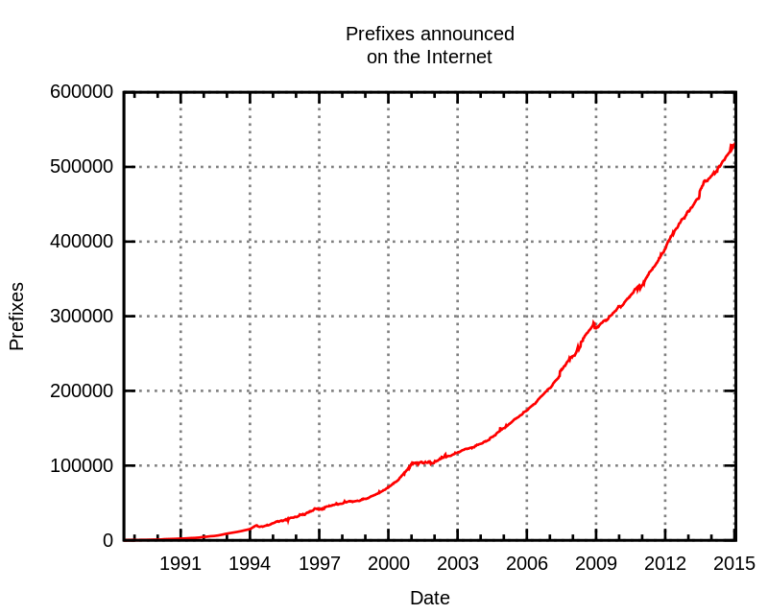
A graph showing BGP table growth on the Internet. Source: Wikipedia
Inflexibility: BPG-ran routers can’t predict if and when network congestion will occur because their packet forwarding mechanisms can only reach the packet’s transport layer. This means the router can’t access information such as the state of the packet and the optimal path for the packet to reach its destination. It is possible to manually control some aspects of path selection, but this is still not scalable enough.
Security issues: Internet traffic almost always involves packets being transferred through several autonomous systems (eg. an ISP and its infrastructure) that have previously agreed on terms and conditions under which traffic is allowed. Autonomous systems have to trust each other and this is where the problem arises.
Looking Glass is a program specifically designed for the purpose of finding out the process of path selection based on manual rules set for a given router. This also allows insight into packet transfer through several autonomous systems and rules that define optimal path selection.
Mobile and app-based internet forces more and more content providers, content publishers, and online vendors to simplify navigation and improve user experience, primarily the page load time of their website. Just one second of delay can cause up to 7% loss in customer conversions, which is more than harmful. This is where a content delivery network (CDN) comes in as essential for those interested in global Internet connectivity.
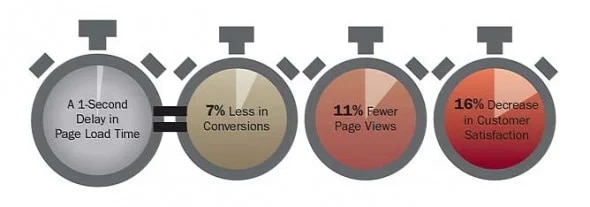
Here are 8 reasons why implementing CDN into your business ecosystem is something you must consider:
Global accessibility: Content Delivery Networks help make content globally available and accessible, bypassing the problem of content source and destination by having multiple Points of Presence (PoPs). This facilitates global business transaction
Going global is the first step to a high-quality
Scattered Points of Presence: if the main server of a network is a whole continent away from a customer located in Asia, when the customer makes a query, content delivery will be slow. For this reason, CDNs use servers that are located as close as possible to the geographical location of the end user. This significantly speeds up content delivery.
online business.and eliminates disturbances (slow or unsuccessful transactions).
This illustration shows how a CDN Provider located in New York delivers its content across the globe. Orange = location of PoPs and Delivery Nodes storing replicated content that the CDN Provider wants to share with their users. Green = the distance between end user and the PoP closest to them.
Automatic data analytics: Usually, CDN Providers charge for their services based on data volume (they often charge for every GB of data delivered). This includes data analytics: most used search queries, time, location, etc. Data analytics allows companies to improve their business model and see which practices work, which don’t, and where there is room for growth.
Less delays: CDNs use globally accessible servers and replicate content. Their end users are usually closer to PoPs than the main servers which makes for less delays in content delivery.
Lower rates of network congestion: It’s simple – when congestion rates are lower, performance is better. Network congestion often occurs when a large number of users want to access a website at the same time. Being able to redirect users to replicated content leads to less network congestion, superior performance overall and better User Experience.
Protection against DDoS attacks: the purpose of DDoS attacks is not just to make a website temporarily unavailable. They aim to diminish trust in the company running the website in question, negatively influence public opinion about CDN Providers and other related services. All of this inevitably leads to financial losses.
Increased reliability and trustworthiness: There is a very high probability the content delivered through CDNs will maintain optimal quality in comparison with content delivered through other sources. CDNs are designed so content could be distributed at a faster rate. This makes the factual information shared more trustworthy, which has a positive effect on customer satisfaction.
Lower overhead costs: CDNs eliminate having to pay for expensive foreign services and for multiple providers. Content distributed through these networks is available globally with the help of just one provider. Paying customers can allocate Internet traffic to more Delivery Nodes if that’s what they need and that solves the problem of content availability effectively.
Other than the top 8 things, here’s a short list of some other benefits that a CDN can provide to a website which can greatly improve site performance and user experience:
To succeed, organizations need a CDN partner that can support their needs with ease and agility – but how do you select the right one, given that technical and business requirements are constantly changing?
Choosing a CDN that stays ahead of the continual advances in web and mobile technologies as well as the evolving threat landscape – will enable you to consistently offer your customers the best possible online experiences while minimizing operational complexity and overhead costs.
But the question arises: what is the best CDN?
The only answer to this question is: best CDN depends on your use case.
Choosing a CDN (content delivery network) can be a daunting task. There are a range of available solutions out there, and at first glance they can appear similar.
However, once you get into the details you will find that there are some striking differences between the CDNs.
This may sound obvious, but it’s important to note. Before you start comparing and analyzing various CDN providers, you must first take stock of your own needs and requirements.
What kind of a website do you have? Are you running an ecommerce shop? Where are your users located? What kind of media do you serve your users the most (text, video, etc.)? What’s your budget?
You have to answer lal these questions first so you can formulate a general idea about what do you need from your CDN provider. Different CDNs can have different specialties, and it’s important to pick one, or several, that will meet your specific needs.
Geography plays a major role in content delivery.
You need to know where your audience is located. Is it local, regional, or global?
It’s important to choose a CDN that has Points of Presence (PoPs) in the areas where your audience is located. Each PoP should have adequate egress capacity to ensure your audience receives the fastest possible experience. The CDN should also have peering agreements with the local Internet Service Providers (ISPs) and last-mile networks that serve your audience, in order to eliminate “last-mile” bottlenecks between the CDN and the user’s internet connection.
If you’re planning to only deliver content to a local audience, you don’t need a global CDN, you’re probably better off with a local one.
Also, some CDN providers specialize in specific geographic areas. For example, if you want to deliver your content to China from, let’s say, US, you’re not only facing geographical distance – you also need to take into account additional requirements that Chinese government imposes.
One of the crucial factors in your decision will most likely be the speed and reliability of a CDN. The three most important ways to measure speed and reliability are:
The CDN service provider you select should have a large network. Simply put, the more servers you have, the faster and more reliably content you can deliver your content. More servers equals less buffering, greater redundancy, more scalability, and so on.
Since end users are connecting to your site via a CDN, you need to ensure maximum uptime and availability. Assess CDNs on their ability to be held accountable to an SLA.
It’s very important to prioritize both cost and performance before selecting a CDN.
You need to understand how a few milliseconds of latency might affect your user’s experience. If you are running a mission-critical website or application where a few hundred milliseconds makes a big impact to your business, you might want to choose a CDN that has the best possible performance.
However, perhaps your website or application is not mission critical, and those few hundred milliseconds are invisible or inconsequential to your users. In that case, you could choose a CDN that costs less and has almost as good a performance against the best performing CDN.
Security is a serious consideration when choosing a CDN. Features such as encryption, DDoS mitigation, and compliance all play a key role in selecting a vendor. Encryption ensures that your customers’ identities, transactions, and the integrity of your website are protected in transit between an endpoint and the CDN’s edge.
DDoS attacks are certainly a pervasive force and something that cloud vendors fight on a frequent basis; ensure that the vendor has the requisite strength to fend off these attacks so that your content is always able to be served. Finally, compliance plays a key role in vendor selection if the content you are serving from a CDN requires an extra bit of care (eg. sensitive medical information, financial data, etc.).
Every good CDN provider should offer you assistance whenever you need it.
The quality of a CDN’s support and services staff directly reflects the quality of the CDN. The right CDN offers teams with a depth of expertise and breadth of experience – teams who have helped design the Internet’s most innovative sites, deliver its biggest events,and mitigate its largest attacks. They should be able to provide expertly managed delivery, broadcast, and security services with 24/7,proactive, round-the-globe monitoring and support – giving their customers access to top-flight specialists in web, mobile, streaming,and security whenever and wherever they need it.
The industry has grown significantly in recent years, as the importance of a CDN has also grown. The CDN market was valued at USD 9.24 billion in 2018, and it is expected to reach a value of USD 38.97 billion by 2024, at a CAGR of 27.30%, over the forecast period of 2019-2024.
Emerging mobile content delivery networks, growing internet traffic, and increasing video content over the internet are some of the factors providing growth opportunities to the content delivery networks market.
The Internet is always evolving and so is the need for faster websites and better user experience. Nowadays, there are more and more CDN providers, but here is a quick list of the top 25:























Swift expansion of Internet-based services such as online video, streaming media, online music, online games have increased the need for expansion of the web, as well as the demand for better Quality of Service (QoS).
CDNs have emerged as an ideal solution to meet all these problems and to meet the demand of delivering better quality content to users. The CDN market is driving on the growth of high implementation rate of CDN solutions in the U.S., Europe (EU), and Asia Pacific (APAC) regions.
The content delivery network (CDN) market was valued at USD 9.24 billion in 2018, and it is expected to reach a value of USD 38.97 billion by 2024, at a CAGR (Compound Annual Growth Rate) of 27.30%, over the forecast period (2019-2024).
North America holds the largest share in the CDN market. North America has a high internet penetration rate, which is expected to aid the growth of content in the region. With the presence of the market leaders and early adoption of technologies across various end-user verticals, North America stood as the leading regional market and is expected to continue its dominance, over the forecast period.
There are several new trends that helped increase the growth rate and the adoption rate of CDNs:
Over the course of the last decade, the number of internet users worldwide has tripled from 1 billion in 2005 to 3 billion in 2015. Smartphones helped out as well, as 2 out of 3 adults in USA owns a smartphone. Worldwide, smartphones will make up roughly 50 percent of mobile phone users by 2017. Traditional solutions, like an accelerated WAN, can’t keep up with the pace of change and the amount of dynamic content and diverse access points.
As users become more sophisticated – and 3G and 4G networks more prevalent – expectations for website speed and performance, no matter the device, are higher, as mobile users expect a similar web experience to desktop. Google started the mobile friendly search initiative, which, in other words, means that mobile-optimized website (design, performance and speed) could offer a competitive advantage in search results. This made way for dynamic mobile optimized CDNs.
Global B2C ecommerce sales are expected to reach $1.92 trillion U.S. dollars in 2016. In the first quarter of 2015, retail ecommerce sites had more than $80 billion in sales, compared to $26.5 billion in the first quarter of 2006. CDNs became an imperative for smooth eCommerce websites.
More than 6 billion videos are viewed on YouTube’s platform each day. Facebook reported its users watch about 4 billion videos every day, 75 percent of them on a mobile phone. A CDN reduces latency for high bandwidth content like streaming video.
Whenever customers type in their credit card numbers to make a purchase online, they are placing their trust in that business. DDoS attacks are on the rise and new ways of Internet security are being developed; all of which have helped increase the growth of CDNs, as cloud security adds another layer of security. CDNs can greatly improve the security of a website.
Here are some factors contributing to the growth of CDN market:
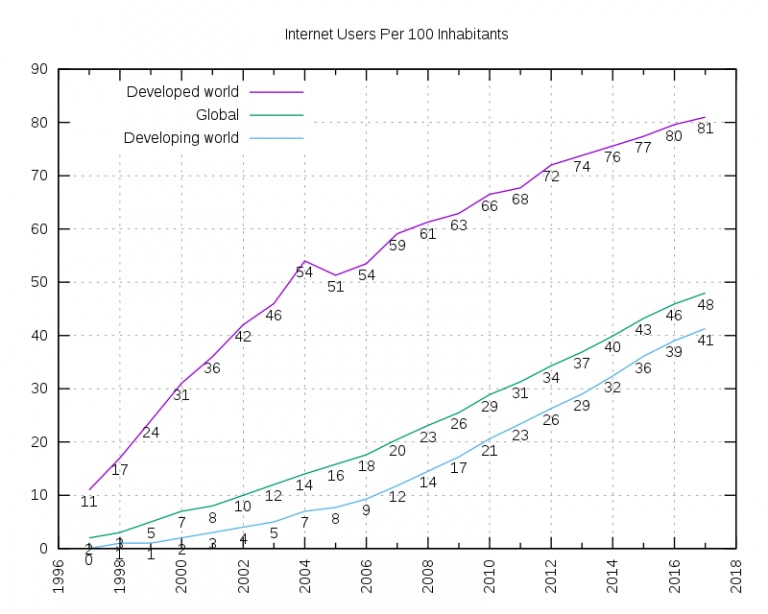
Projections for CDN markets have proven to be overly conservative because the markets are, in fact, growing faster than expected. The following two graphs illustrate projections made in 2013 for the period between 2010 and 2017.
It was estimated that by 2017 the CDN market will be valued at $4.5 billion, which is $2.83 less than the actual value it reached in 2017.
As viewers consume more video, more often, for longer periods of time, at higher quality, and on more devices, the content delivery market is as hot as it has ever been. It’s also important to note that the two major things that have marked the evolution of internet are mobile technology and social media. Additionally, growing IP video traffic is expected to boost the CDN market. Today, video consumption over mobile devices and internet is growing at unparalleled rate. As network operators become aware of advantages of CDN, numerous cable operators and telcos in Europe and North America have launched CDN initiatives.
Numerous industry verticals that use CDN include advertising industry, media and entertainment, gaming, government, educational and healthcare, online music retailers, consumer electronics, mobile operators, and internet service providers among others, launching a perfect background for CDN to grow.
The impact of DDoS attacks is much more than meets the eye. Not only can these attacks inflict huge economic losses, they can also have a serious impact on the reputation and the image of the victimized company or organization.
Research has shown that it takes at least 10 hours before a company can begin to resolve an attack, while it takes 4.5. hours on average before the attack even gets detected and an additional 4.9 hours before mitigation can begin. The average cost of an attack is $100,000 per hour, meaning that a DDoS attack can cost 1$ million before an Internet-reliant firm even starts to mitigate the attack.
In order to protect your company, you need a mitigation protection in place, to keep both your brand reputation and IT infrastructure out of the harm’s way. Any web solution must fit the business requirements. Defending against DoS attacks occurring at the network layer requires a network architecture that can absorb large bursts of traffic and that filters all traffic so that only web traffic is permitted onto the network. Every business is different and requires a different approach.
These are the key questions to ask when it comes to choosing a DDoS mitigation solution:
Video streaming is one of the largest mega-trends today. It’s a whole new way of consuming content, involving specific technologies and challenges.
Video is currently the most requested content format on the Internet. Distributing video using CDN requires a different approach than distributing other types of content.
The very nature of video as content is different because users (usually) want to watch it instantly and not download and watch it later (unlike having to download and install an app before being able to use it).
You can broadcast live streams through a Content Delivery Network (CDN) such as Akamai, through the KMC. The encoding software installed (such as FMLE) encodes your real-time camera signal and sends it out through a secure RTMP connection to the CDN. Then, using a Kaltura Player, you can embed the live broadcast in your websites. You can set the live stream entry metadata and specify broadcasting settings in the KMC in the same way VOD content is managed. By using a CDN for live streaming, you guarantee a better experience for your viewers worldwide.
There are two types of video content:
There are also two types of video content providers:
Users want to watch videos now, without delay. To achieve that goal, CDN Service Providers use advanced technologies:
RTSP (Real Time Streaming Protocol): RTSP is a network control protocol designed to control streaming media servers and a set of simple commands for users, such as play, pause and record.
RTP (Real-Time Transfer Protocol) is another protocol, responsible for the transmission of streaming data. Other protocols used are UDP (User Datagram Protocol) and TCP (Transmission Control Protocol).
The main advantage of RTSP is it doesn’t require local storage content. All content is live access. Its disadvantages are higher price, complex implementation process and no possibility for CDN support. That’s why today it is rarely used.
ABR (Adaptive Bitrate Streaming): This streaming technology is based on HTTP (Hypertext Transfer Protocol) and progressive downloading (downloading and watching smaller chunks of video content at a time while the rest of the video is still being downloaded).

An encoder is used to produce smaller bit rates from the original video file. These smaller chunks of information are stored on the user’s computer and are pieced together through a Manifest File that is being downloaded every few seconds.
The smaller chunks of information are in fact several seconds long pieces of video content. They can be downloaded in different qualities (High, Medium, Low Bitrate Stream). The quality affects their total size. The size of these chunks depends on detecting the user’s bandwidth and the technical specifications of the device the user is using for streaming video. This process of determining the size and quality of downloadable chunks runs automatically.

ABR’s main advantage is the fact it is based on HTTP, which makes it optimized for excellent performance on the Internet. It is also compatible with CDN: video content can be stored in its Delivery Nodes, which makes it more accessible for the user.
Today, ABR is implemented for use on various platforms and operating systems, including Flash (Youtube), iOS and Android. MPEG-DASH is an internationally standardized bit rate streaming technology used across different devices and wireless networks.
Despite the advent of ABR and HTTP streaming, there still is a need for live video delivery, since live video can’t be cached like the content that has been previously recorded. Progressive downloads are the favourable option, in contrast to direct downloads where the entire video clip needed to be downloaded to a viewer’s computer before it could be viewed. While this is acceptable for downloading a game or computer application, the tolerance level of viewers waiting for content to download—especially something such as a movie, which could be over 1GB in size, was low.
The first huge notable website that relied on progressive downloads was YouTube. the CDN begins delivering the download, but a viewer can begin watching content within the first 3-5 seconds, on the assumption that the viewer’s fast internet connection will continue to download the video clip at a fast enough pace to avoid running out of viewable content. As the speed of the internet connections outpaced the bitrates used for standard-definition content, many viewers would have the entire video clip downloaded before they were even halfway through viewing the content.
The best solution so far is called HTTP streaming, and it is coupled very tightly with adaptive bitrate (ABR) encoding and delivery. HTTP streaming uses generic HTTP servers (often based on Apache or Windows Server) to deliver on-demand video files the same way that other HTTP website content—such as images and text files—is delivered. Adaptive bitrate is added to a CDN, which converts a video stream into fragments or chunks, often 2-10 seconds in length. ABR creates discrete streams at various bitrates and then uses feedback from the internet user’s video player to dynamically detect the optimum network speed for delivery of the video clip.
Streaming servers deliver the content at the time of a request, but only deliver the bits requested rather than the entire length of the video clip. This was helpful for the content owner who was paying the CDN for delivery by the bit, since a viewer choosing to abandon viewing of a clip halfway through its duration would not have downloaded the entire clip, regardless of the viewer’s internet connection speed.
One of the latest trends in technology, the 4K Ultra HD is about to get much bigger. The impact of 4K is growing month by month. The new resolution format itself is slowly starting to remake perceptions of where the entire visual media industry will be going over the next few years. Consumers want high quality and resolution, and broadcasters want their ultra HD recordings and their live casts available everywhere. Mobile browsing is the largest growing and the most adopted megatrend so far. It’s taking over desktop and getting bigger every day.

A fast high-speed Internet connectivity is crucial to the wider proliferation of 4K. The data loads that 4K streams is truly massive and content broadcasters are painfully aware of this. Faster connectivity is a major issue that 4K providers are tirelessly working on. An expansion in the number of homes that can enjoy access to internet speeds that at least consistently cover the minimum of 25Mbps necessary for reliable ultra HD streams. With the fast expansion of 4K and high resolution streaming, the adoption of CDNs is only expected to grow.
If your online business is faced with increasing traffic and number of visitors (which is a good thing), choosing the right CDN Provider is a step in the right direction if you want to improve website speed and UX.
The CDN market has grown a lot recently and is only expected to become bigger and bigger. There are more CDN providers than ever nowadays and it’s getting harder to choose the right one for a business, since it’s hard to narrow down your options and list the needs for your business.
But there are ways to do it.
Successful testing of a potential CDN provider is performed in two phases:
Most CDN Providers charge for their services based on data volume. The CDN market has become huge and, with all the choices, it is hard to say what provider is ideal for what purpose. This is especially true in the case of small to medium-sized companies who don’t have a large IT department due to various different reasons: unsure where to start, how to prioritize IT tasks according to what phase of development the company is currently in.
In order to be functional, every CDN system has to be designed according to 6 principles:
Basic and individual functionalities:
Different customers need different functionalities that fit their individual needs, but some functionalities are basic and should be available for each customer, including:
Knowing how well CDN services perform is one of the key pieces of information you can have. This includes knowing at what speed different CDN Providers are able to deliver content.
Be sure to calculate the minimal, maximal and average values of latency and throughput in times of regular and heavy traffic.
Here are some common reasons why servers are still slow even though they are located close to the end user:
Most CDN Providers have an around-the-clock Customer Service, but here are some other qualities to aim for:
CDNs are known to provide a more secure network, reduced loading time of your page, manageable traffic, maximum availability, and so on. An irreplaceable tool that will improve the entire technological infrastructure that backs up your business. But why trust it with only one CDN provider?
What if you could hop from one CDN provider to another, at all times by redirecting user requests to the optimal content source based according to your business needs. This is known as Multiple Content Delivery Network, or multi-CDN.
Multi-CDN or Multiple Content Delivery Network is an approach to content delivery that utilizes services from more than one CDN provider at any given time to improve key factors like performance and functionality.
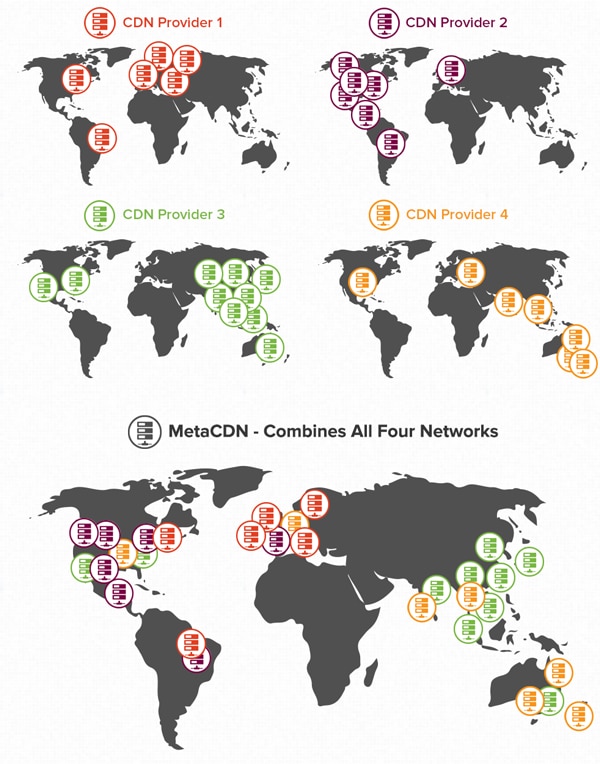
A visual representation of Multi-CDN networks using MetaCDN’s (a CDN Services Provider) partner networks. Source: Billy Phillips – Peer-to-Peer and the Multi-CDN Approach
Such diversification of your CDN providers is known to be less risky. And you can easily balance availability and performance of your website by loading various servers on the cloud, differently.
Using multiple CDNs is smarter than using one CDN because:

There are also several direct advantages that need to be mentioned:
Most commercial CDN Service Providers nowadays use Multi-CDN to improve on their services. They often collaborate with each other on a P2P basis. If one CDN Service Provider is not able to deliver a quality service to the user requesting content, it forwards the request to another CDN Service Provider they are affiliated with.
Content Providers can design their own Multi-CDN if they partner with a DNS Service Provider.
In this case, the DNS Service Provider consigns their DNS servers infrastructure to the main organization (CDN Service Provider) and all other providers the main organization is affiliated with. Then, DNS servers run a performance analysis of all CDN Service Providers and allocate user requests based on the results.

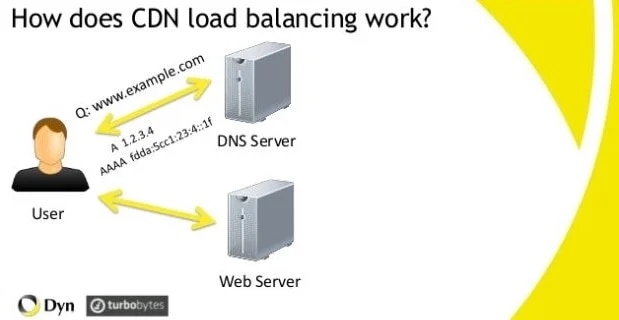
Pairing a managed DNS solution with your CDN provides your website with extra performance, reliability, and flexibility.
The Domain Name System (DNS) is a hierarchical distributed naming system for computers, services, or any resource connected to the Internet, or a private network. It associates various information with domain names assigned to each of the participating entities. It basically serves as the phone book for the Internet by translating human-friendly computer hostnames into IP addresses, but unlike a phone book, it can be quickly updated.
DNS keeps you connected to your customers.
Every first user interaction with a website starts with a DNS, but if it goes down, the site can’t be accessed. With a managed DNS solution, the probability of a total network outage is decreased because DNS providers build their networks 100% reliable. Having an “indie” DNS provider, as opposed to a combined professional CDN/DNS provider is a smarter bet because if your combined provider’s network goes down you lose both ways.
A combined DNS/CDN solution ensures the maximum performance of the website, quickly delivering the content to ensure the highest user experience possible, giving the flexibility when it comes to updating the website. Pairing a CDN with DNS allows you to:
Every user’s first interaction with a website begins with a DNS query. When a user lands on a page, dozens of distinct DNS queries are issued to identify the correct source for all content. DNS resolution can account for as much as 29% of initial page load time. Poor DNS means slow page loads, leading to dissatisfied users and ultimately the loss of business. You can basically distribute traffic across multiple CDNs and endpoints to optimize the performance of your website, ensuring your content is always available, even if a CDN is down.
According to a study done by Amazon and Google, you suffer a 7% decrease in sales if your website doesn’t load in under 3 second.
As your business grows, your DNS follows your steps. Managed DNS allows you to add services and features and it’s simple to update. Managed DNS services can help you boost revenues, reduce website abandonment, and improve customer satisfaction by quickly connecting users to the resources they need. A good first impression starts with DNS.
These are the key advantages of a paired DNS/CDN solution:
Most CDN providers implement and manage their own DNS infrastructure. Some CDN providers have productized their internal DNS networks to supplement their core service revenues, but a CDN provider can’t match the flexibility, performance, and scalability of an independent service provider that focuses on DNS. As a perfect complement to a CDN, managed DNS solutions are specifically designed to extend website performance and reliability. Managed DNS services are ideal for companies and brands of all sizes. They offer global footprints and use advanced load balancing and routing techniques to minimize latency, maximize availability, and minimize costs. DNS is the first part of the lookup process. It is essentially what separates online brands from their consumers. If your DNS fails then your brand may as well not exist. Latency or Resolution Time has been a widely acknowledged consideration for e-retailers focused on end-user experience.
Internet Performance solutions are responsible for the delivery of a brand’s content and end-user experience. Understanding customer demographics is key to positive user experience and good business. The advantages of pairing CDN with DNS are, virtually, infinite.
These are some additional features that a paired DNS/CDN solution provides:
It is widely accepted that content delivery networks are a great way to increase a website’s performance, as providing advanced acceleration services that can improve end user experience dramatically. However, with so many CDN providers entering the crowded and competitive market every year, organisations looking to boost their online performance are facing ever greater dilemmas – which CDN provider is best, how should you measure content delivery network performance and which do you select to accelerate your data?
There are several methods that can be used when analysing the performance of a specific content delivery network provider. The most important benchmarks include:
Server side performance monitoring:
This method of testing simulates end user data requests, and then measures how quickly a web page responds to the request. Whilst this is useful for determining response speeds, it isn’t perfect. This is because it often only measures the time it takes for the initial document files to be delivered, neglecting files such as images, CSS files and JavaScript. This type of measurement is therefore highly unreliable, and can in many cases be seconds faster than loading speeds are in reality.
Synthetic transaction monitoring:
To overcome these server side monitoring drawbacks, a second, more accurate method can be used. Synthetic transaction monitoring incorporates emulators and real world browsers to test predefined data requests from many different locations. Whilst this is supposedly as close a method to measuring real world end user performance as possible, it can also be plagued with inaccuracies. This is because it does not accurately source requests from the exact locations that your specific customers are based.
Measuring the performance of a few users:
This method is a more accurate way of measuring website performance, especially when compared to the previous options. By taking a selection of your end users and measuring how long it takes for them to access your pages, you can use the averages of these results to make generalisations about the speed of your content delivery network.
Cost savings:
CDN monitoring can help you to determine the usage and importance of various pages and pieces of content within your website. This information can help to optimize data storage and indexing to reduce CDN costs.
Protecting against attacks:
Cyberattacks such as DDoS and credential stuffing attacks commonly target only a few pages within an organization’s website. By monitoring the usage of various pages and looking for anomalies, you can identify and block malicious traffic against your sites.
Measuring the performance of every end user:
This is the most accurate method of measuring the performance of your website. By measuring all actual transaction times across a network and from all users, you can record response times from a server, network and application perspective. This, however, can be very expensive and difficult to administer. Real end-user experience and CDN performance can be measured using Last mile testing. Despite shortcomings, Last mile measurements are more realistic as they measure how quickly your content is delivered from CDN servers to end-user device. Because it incorporates the last leg of connectivity service required to deliver content, Last mile testing provides more accurate picture on end-user experience.
In addition to these benchmarks, there are certain aspects of a CDN’s network configuration that can also be considered, depending on your exact requirements:
Monitoring cloud performance means measuring the level of service that the customer is acquiring from the entire cloud environment, usually from a cloud service provider, and measuring how well a service the provider is offering. To understand how all of the components (back end, front end) are attributing to utilize the full potential of such remote IT infrastructure, for both end user and a service provider. Cloud performance management should thus both be performed by the service provider as well as the cloud consumer (companies, organizations, commerces), and they will differ in reporting.
Moving your system to the cloud is not enough without adequate monitoring, and cloud performance management strategy will be critical for vendors entering the cloud computing market. Many cloud monitoring tools can be acquired from third parties, and it is best to use more of them in a combo.
Taking the time to consider these factors will help make sure that you get the most out of your online acceleration services.
Contact us to get the most out of your CDN.